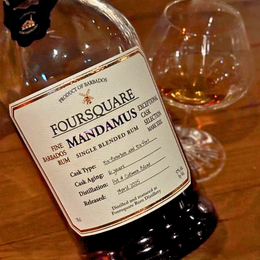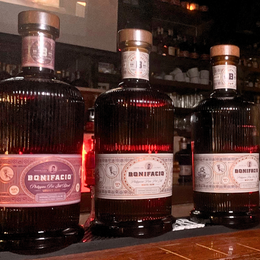
Ever wondered how did the term “Navy Rum” come about?
It all began with the traditions of the British Royal Navy in the 1700s. In the days of yore, traversing the vast oceans meant facing unpredictable weather and countless perils, making a swig of rum a welcome respite from the harsh realities of life at sea.
Rum was originally introduced by the British Admiralty as a means of ensuring sanitary water for sailors by mixing it with rum. Beyond its practical applications, the daily rum ration, affectionately known as the "tot," played a pivotal role in maintaining morale, fostering camaraderie, and even served as a reward or punishment system.

Rum rations were probably the biggest exercise in alcohol distribution in modern history - the British Royal Navy helped bring rums to wherever a ship could go to. (Image Source: Radio Canada International)

This transformed the Royal Navy into being pioneers of rum blending with extensive rum holdings in the 1700s and 1800s, especially after capturing the Caribbean islands. Imagine vast cellars brimming with barrels of rum sourced from across the Caribbean, each boasting its own unique character and flavour profile. This early rum blenders from the British Navy laid the groundwork for modern blending techniques, which remains crucial for achieving complexity and balance in blended rum today. However, as the world evolved and the Navy modernized, so too did its practices. In the 1970s, the UK Government finally abolished the rum ration.

Initially, the Navy considered a brandy ration, but that idea was quickly scrapped because brandy was often the drink of the (French) enemy.
In the wake of this decision, “Navy Rum" quickly emerged amongst commercial rum bottlers who wanted to capitalise on the nostalgia and tradition associated with the term. Popular brands like Pusser's Rum evoked a connection to the navy (Pusser itself refers to the officers responsible for distributing rum) and marketed themselves as the same kind of rum enjoyed by sailors for centuries.

Initially, this strategy worked and Navy Rum did appeal to consumers who yearned for a taste of maritime history. However, essentially anyone and everyone could label their rum as “Navy Rum”, regardless of its contents. As time passed, the term "Navy Rum" came to be diluted and overused, much to the chagrin of rum lovers. Many brands of so-called “Navy Rum” were criticised for falling short of the required strength of 57.18% ABV, not aging their rum long enough, or not sourcing from the appropriate Caribbean distilleries. Moreover, some blends were even adulterated with dosage, which in the eyes of rum fans, seriously compromised their authenticity. It’s entirely understandable why one would feel disillusioned with modern versions of “Navy Rum”.

Velier stepped up and did us a solid. Under Luca Gargano, who has always been an advocate for transparency and authenticity in the rum world, Velier sought to recapture the essence of the Royal Navy rum blends and created the Velier Royal Navy “Very Old Rum” in 2017.

(Source: Elysian Whisky Bar, Melbourne)
So what exactly is proper Navy Rum?
First, Navy Rum refers not only to its style but also to its alcoholic strength. It must be the classic definition of “full proof,” defined as the concentration of alcohol that, when mixed with gunpowder, can ignite. If the alcohol is overly diluted, the gunpowder won't light and the batch of rum would fail the test. In modern terms, “full proof” is approximately 57.18% ABV, which one would expect to be the standard strength for Navy Rum.
Secondly, Navy Rum wasn't produced by a single distillery but was a blend of rums from British colonies. The ratio has shifted over time but towards the end of the Navy’s rum ration in 1970, the blend consisted of approximately 60% Demerara rum from Guyana, 30% Trinidad rum, and 10% from other colonies like Barbados, Jamaica, or even Australia. The Demerara rums formed the backbone of the blend with Trinidad rums adding complexity.

Of course, truly authentic Navy Rum is not filtered or adulterated with sugar. Lack of added sugar guaranteed that the sweetness in the rum came solely from the natural aromas of the rum and the aging process.
Velier crafted its rum with these very criteria in mind. The first expression – Velier Royal Navy “Very Old Rum” was composed of Guyanese rum, Jamaican pot still rum, and Trinidadian rum (mainly from the iconic Caroni distillery).

Today, we have with us the second release of Velier’s Royal Navy Rum, named “Tiger Shark” – a playful reference to a nickname given to Luca by his Polynesian friends. The exact ratios have not been disclosed, but this expression primarily includes rums from Worthy Park (Jamaica) and Demerara Distillers Limited pot still rums (from Guyana). The weighted average age of the blend is 14 years and of course, this is bottled at standard proof of 57.18% ABV.
I recently had the opportunity to taste the Tiger Shark at La Maison du Whisky.
Velier Royal Navy Rum, 2nd Edition - ‘Tiger Shark’, 57.18% ABV – Review

Nose: Evocative and bursting with flavour. It's potent, it’s estery, with tons of sweet honey, caramel, and cinnamon intertwining with ripe raspberries and a touch of overripe bananas. Hints of gasoline recall the character of Trinidadian rum (TDL, Caroni, etc), with a background of leather, old wood, dried apricots, and monk fruit adding depth. I also loved the fresh blood orange note that cuts through the thick caramel sweetness and adds a ton of vibrancy.
Palate: Initial sip proves to be balanced and flavourful, with raisins, oak, vanilla, tobacco, and leather. But it quickly builds heat to become lively and punchy; a crescendo of spices, pepper and mint. Towards the mid- to late- palate, the heat then mellows to revealing sweet caramel, liquorice, pepper, candied orange peel, and roasted pineapple. It's undeniably hot, but bearable, with the rich tropical notes offering a good counterpoint to the spice.
Finish: Long and lingering, characterised by heavy cinnamon, coffee grounds, woodiness, and eucalyptus. Spices and warmth persist on the back of the tongue and fade very gradually.

My Thoughts:
This is a lovely challenging aficionado’s rum. It’s got a multitude of nuances and a fair bit of heat which rum fanatics will get past to appreciate its complexity and character. For anyone else fairly new to navy proof rum, I’d recommend giving this a bit more time for the alcohol to mellow, or actually adding a few drops of water to bring out that aromatic oak, spice and tobacco.
While the spice occasionally threatens to dominate, the underlying flavour and complexity shines through, and it really rewards you if you are patient with it.
The nose is my favourite aspect – it’s filled with honey, tropical notes and funk. I would really have loved to see a bit more of the Worthy Park funkiness coming through on the palate. And while I understand the shift in ratios and the high cost of Caroni rum today, a touch more of those exciting Caroni-like gasoline, rubber and wax notes would have elevated this blend even further in my book.
My Rating: 7.5/10
|
Score/Rating Scale :
|

@CharsiuCharlie







